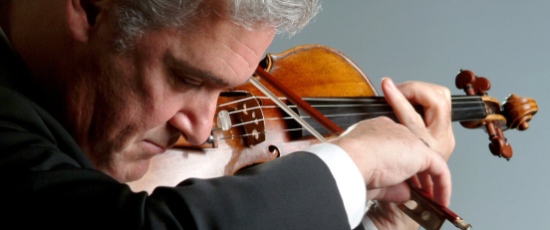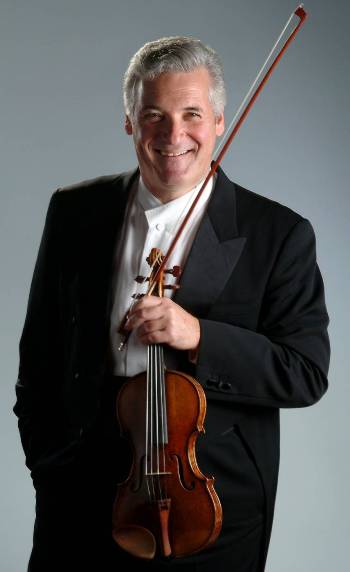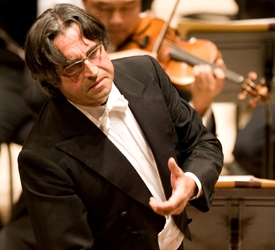Virtuosity on display, CSO and Zukerman burnish Brahms concerto, 2nd Symphony
 Review: Chicago Symphony Orchestra conducted by Riccardo Muti; Pinchas Zukerman, violin. At Orchestra Hall through March 10. *****
Review: Chicago Symphony Orchestra conducted by Riccardo Muti; Pinchas Zukerman, violin. At Orchestra Hall through March 10. *****
By Lawrence B. Johnson
Sometimes, in the course of a symphony orchestra season, it’s good just to hear the band dial up the core German repertoire and show what it can do. That’s exactly what the Chicago Symphony Orchestra and music director Riccardo Muti did March 8 in a sumptuous double dose of Brahms, the Violin Concerto with soloist Pinchas Zukerman and the Second Symphony.
 Zukerman, now 63 and for many years divided in his commitments between playing the violin and conducting, engaged the Brahms concerto with the passion, daring and finesse of a musician whose soul resonates in the fiddle. It was a bravura performance, as earthy as it was brilliant, and one in which violinist and conductor shared an interpretative view that framed intimacy within unfettered expansiveness.
Zukerman, now 63 and for many years divided in his commitments between playing the violin and conducting, engaged the Brahms concerto with the passion, daring and finesse of a musician whose soul resonates in the fiddle. It was a bravura performance, as earthy as it was brilliant, and one in which violinist and conductor shared an interpretative view that framed intimacy within unfettered expansiveness.
To hear Zukerman’s fierce attacks in the opening movement, and the impulsive rhythms he brought to the finale, was to think back on the late Isaac Stern. Few violinists can deliver that blend of feverish romanticism and tonal luster, but here it was at full throttle in Zukerman’s long, arching lines and magisterial sound. He transformed the famous cadenza into a rhapsodic soliloquy, concentrated, ruminative, elevated with the inflection of speech.
Yet no less captivating were the deep veins of lyricism that ran through those animated movements, to say nothing of the pervasive radiance Zukerman summoned in the concerto’s central Adagio. In that intermezzo-like middle movement Muti’s easy pulse might have been the violinist’s second heartbeat, so naturally did the one match the other. And the CSO showed its warmest colors in enfolding Zukerman’s gossamer phrases.
 The pairing of the concerto with the Second Symphony was, well, a great deal of D major. But it also captured Brahms at a moment in time, with his romantic wings fully spread.
The pairing of the concerto with the Second Symphony was, well, a great deal of D major. But it also captured Brahms at a moment in time, with his romantic wings fully spread.
The concerto and the symphony were produced in the consecutive years 1877 and ’78. While their musical rhetoric is similar, their dramatic pitch and narrative are quite different. Whereas the Violin Concerto is almost Shakespearean in the way it casts the individual against the natural world, the Second Symphony might be construed as a landscape painting, Brahms’ pastoral symphony.
That said, the grand architecture of the opening movement suggests less of Beethoven – whose shadow had so long loomed over Brahms – than of Bruckner. And the particular beauty of Muti’s account lay in the clarity and cohesiveness with which he built and sustained Brahms’ sweeping design.
 From the start, Muti concentrated on a singing line, buoyed by silky string playing and rippling woodwinds, juxtaposed with the restrained power of gleaming brasses. The scherzo was pure folk dance, skipping and stomping.
From the start, Muti concentrated on a singing line, buoyed by silky string playing and rippling woodwinds, juxtaposed with the restrained power of gleaming brasses. The scherzo was pure folk dance, skipping and stomping.
With the finale, in which Brahms pulls out the stops of joyous engagement with the world, Muti tapped the music’s full measure of ebullience, just as the CSO put on an exhibition of nuanced virtuosity.
It must be a great temptation for a conductor and a high-powered brass department to pour out the finale’s great, recurring fanfares in full voice at the first opportunity. But the clincher of this thrilling Second Symphony was Muti’s forbearance. He piled up the tension by degrees and only at the very end allowed the CSO’s brassworks to unleash its sunburst sound.
Small wonder the audience answered with hall-filling salvoes of its own. No other response would have been emotionally, or perhaps physically, possible.
Related Links:
- A very young Pinchas Zukerman plays the Intermezzo from Schumann’s “F.A.E.” Sonata: Watch it on YouTube
- Zukerman as he appears today: Video of the Bruch Concerto with the Israel Philharmonic
- Performance location, dates and times: Details at cso.org
Photo captions and credits: Home page, top and upper right: Violinist Pinchas Zukerman (Photos by Paul Labelle). Upper left: Conductor Riccardo Muti (Photo by Todd Rosenberg). Lower left: Johannes Brahms in 1970, at age 37.
Tags: Brahms, Chicago Symphony, Pinchas Zukerman, Riccardo Muti


I heard this concert on ABC Classic FM Sydney yesterday afternoon 3/6 coming into it in the second movement.
This movement was played with such intimacy and poignancy I wondered if it was Pinchas Zukerman. I’d love to have a copy of it. It’s the sensitivity of his playing and his preparedness to allow the emotion of the music to speak that I most appreciate.
I heard this concert on ABC Classic FM Sydney yesterday afternoon 3/6 coming into it in the second movement.
This movement was played with such intimacy and poignancy I wondered if it was Pinchas Zukerman. I’d love to have a copy of it. It’s the sensitivity of his playing and his preparedness to allow the emotion of the music to speak that I most appreciate.